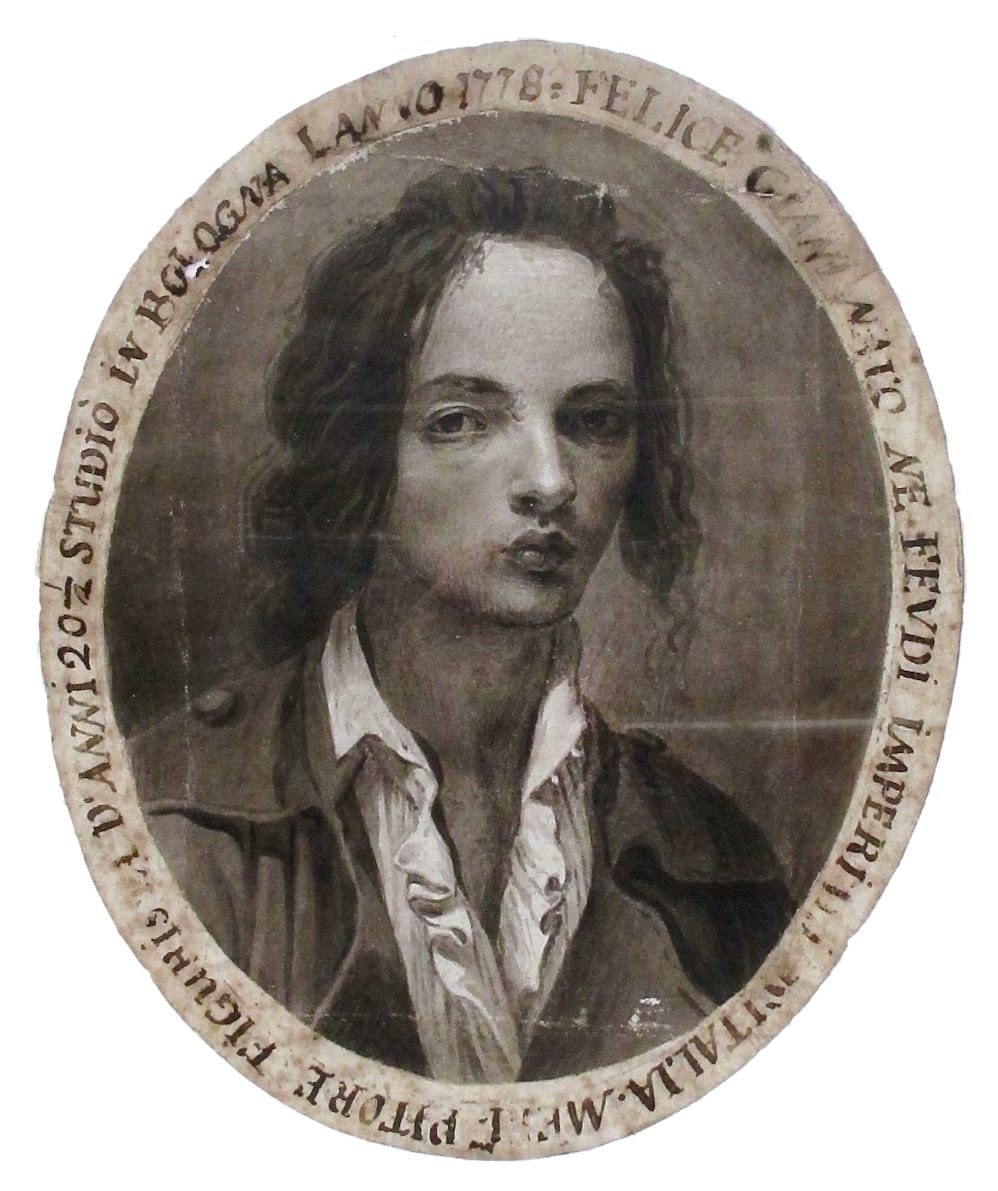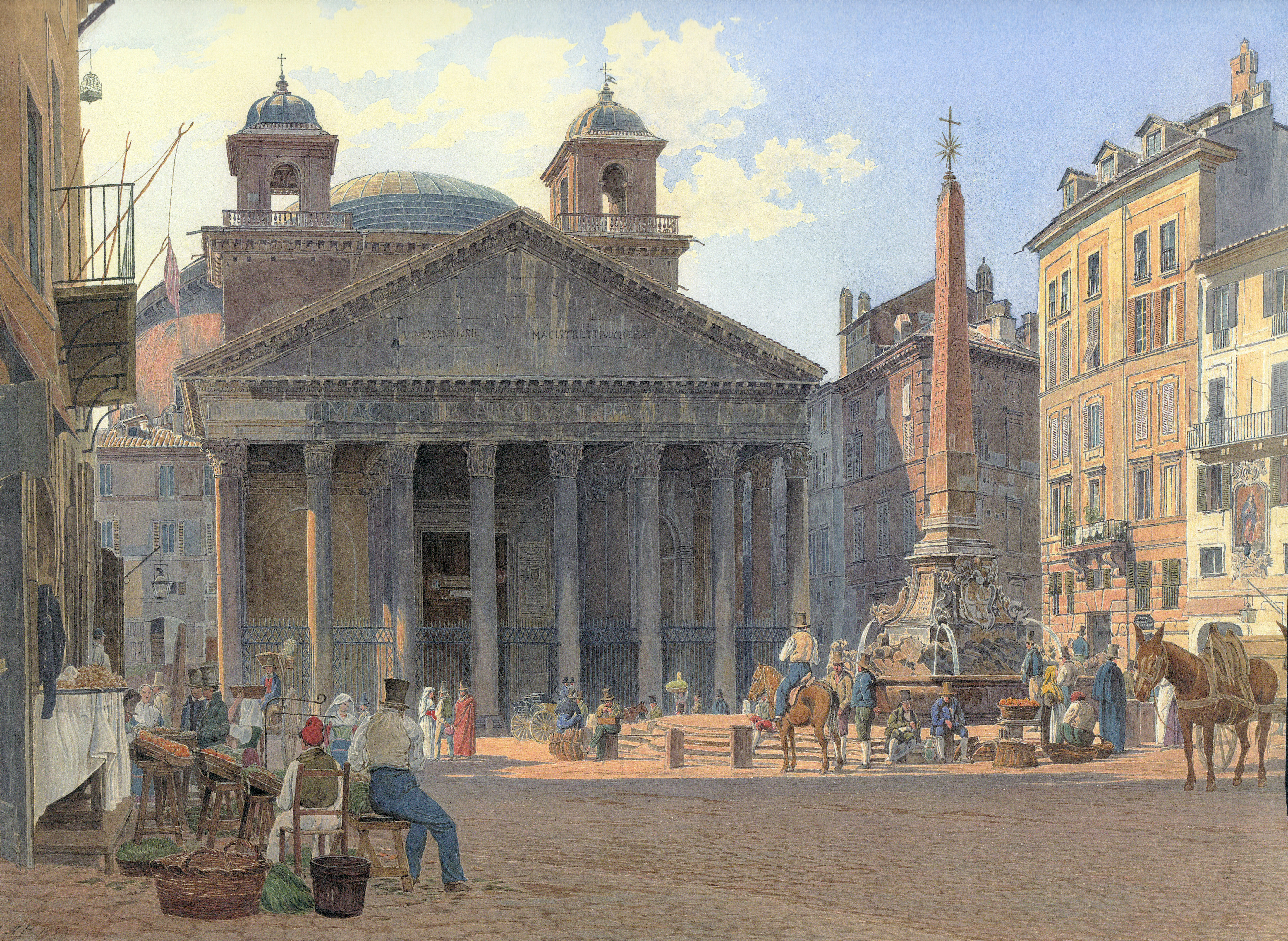|
Felice Giani
Felice Giani (17 December 1758 – 10 January 1823) was an Italian painter of the Neoclassic style. His grand manner subjects often included Greco-Roman allusions or themes. Biography Born in San Sebastiano Curone near Alessandria, he moved to Pavia. In Pavia, he studied with Carlo Bianchi and Antonio Galli Bibiena. He moved to Bologna, in 1778, where he entered the studio of Domenico Pedrini and Ubaldo Gandolfi. He soon moved to Rome and found work in the decoration of the Palazzo Altieri. Between 1780 and 1786, he worked in various studios in Rome, under, for example, Pompeo Batoni and Christoph Unterberger. He then returned north to work in Faenza, where he worked with the quadratura painter Serafino Barozzi, and with Giovanni Battista Ballanti. In Faenza he was involved in a prolific series of projects including the fresco decoration of the Laderchi, Naldi and Milzetti Palaces. The latter is considered his masterpiece. In Bologna, he decorated the Palazzi Aldini, Mar ... [...More Info...] [...Related Items...] OR: [Wikipedia] [Google] [Baidu] |
Forlì
Forlì ( , ; rgn, Furlè ; la, Forum Livii) is a ''comune'' (municipality) and city in Emilia-Romagna, Northern Italy, and is the capital of the province of Forlì-Cesena. It is the central city of Romagna. The city is situated along the Via Emilia, to the east of the Montone river, and is an important agricultural centre. The city hosts some of Italy's culturally and artistically significant landmarks; it is also notable as the birthplace of painters Melozzo da Forlì and Marco Palmezzano, humanist historian Flavio Biondo, physicians Geronimo Mercuriali and Giovanni Battista Morgagni. The University Campus of Forlì (part of the University of Bologna) is specialized in Economics, Engineering, Political Sciences as well as the Advanced school of Modern Languages for Interpreters and Translators (SSLMIT). Climate The climate of the area is humid subtropical (''Cfa'' in the Köppen climate classification) with Mediterranean features, fairly mitigated by the relative close ... [...More Info...] [...Related Items...] OR: [Wikipedia] [Google] [Baidu] |
Sant'Andrea Delle Fratte
Sant'Andrea delle Fratte ("Saint Andrew of the Thickets") is a 17th-century basilica church in Rome, Italy, dedicated to St. Andrew. The Cardinal Priest of the ''Titulus S. Andreae Apostoli de Hortis'' is Ennio Antonelli. History The current church was built over a pre-existing one, erected in 1192, called ''infra hortes'' ("amidst the orchards", whence the name ''fratte'', "thickets", from Byzantine Greek φράκτη, ''phráktē'', "hedge") for it was located in a countryside area on the northern edge of the inhabited area of medieval Rome. The church originally belonged to Augustinian nuns. It became the national church of the Scottish people in Rome, until Scotland became Protestant, when in 1585 Pope Sixtus V assigned it to the Minim friars of Saint Francis of Paola. The Scots College, the seminary for young men studying for the priesthood, was located nearby, on the Via del Tritone, until 1604, when it moved to the Via delle Quattro Fontane. In 1942 Pope Pius XII eleva ... [...More Info...] [...Related Items...] OR: [Wikipedia] [Google] [Baidu] |
Pontifical Academy Of Fine Arts And Letters Of The Virtuosi Al Pantheon
The Pontifical Academy of Fine Arts and Letters of the Virtuosi al Pantheon is one of the Pontifical Academies under the direction of the Holy See. The complete Italian name of the academy, Pontificia Insigne Accademia di Belle Arti e Letteratura dei Virtuosi al Pantheon, includes the adjective ''insigne'' (illustrious), often omitted in official English translations. The term ''Virtuosi al Pantheon'' (virtuosos of the Pantheon) is also usually left untranslated, but, in any event, should not be taken in the English musical sense of “virtuoso” but rather “artists of great merit”. The Pantheon in Rome was the historical home of the academy. The term “academy” is meant in the Renaissance definition of the term as an association of learned persons and not an institution of instruction. History The academy was founded as the “Congregation of Saint Joseph of the Holy Land” in 1542 under the auspices of the Cistercian monk, Desiderio d’Adiutorio and was recognized by Po ... [...More Info...] [...Related Items...] OR: [Wikipedia] [Google] [Baidu] |
Marcantonio Trifogli
Marcantonio Raimondi, often called simply Marcantonio (c. 1470/82 – c. 1534), was an Italian engraver, known for being the first important printmaker whose body of work consists largely of prints copying paintings. He is therefore a key figure in the rise of the reproductive print. He also systematized a technique of engraving that became dominant in Italy and elsewhere. His collaboration with Raphael greatly helped his career, and he continued to exploit Raphael's works after the painter's death in 1520, playing a large part in spreading High Renaissance styles across Europe. Much of the biographical information we have comes from his life, the only one of a printmaker, in Vasari's '' Lives of the Artists''. He is attributed with around 300 engravings. After years of great success, his career ran into trouble in the mid-1520s; he was imprisoned for a time in Rome over his role in the series of erotic prints ''I Modi'', and then, according to Vasari, lost all his money i ... [...More Info...] [...Related Items...] OR: [Wikipedia] [Google] [Baidu] |
Antonio Trentanove
Antonio Trentanove (c. 1745 – 1812) was an Italian sculptor and stucco-artist, active in Bologna in a Neoclassical style. He was born in Rimini and studied at the Accademia Clementina. He is best known for his stucco decorations. He completed some stucco reliefs as part of a team led by Felice Giani for the Palazzo Laderchi in Faenza. Some of his other works are in the church of San Girolamo in Rimini, in the church of Santa Lucia in Forlì and the Palazzo Milzetti in Faenza. He later lived in Massa Marittima for some years and died in Carrara. His son, Raimondo, studied sculpture with Antonio Canova. by James David Draper, Guilhem Scherf, Metropolitan Museum of Art (New York, N.Y.), page 308. [...More Info...] [...Related Items...] OR: [Wikipedia] [Google] [Baidu] |
Gaetano Bertolani
Gaetano (anglicized ''Cajetan'') is an Italian masculine given name. It is also used as a surname. It is derived from the Latin ''Caietanus'', meaning "from ''Caieta''" (the modern Gaeta). The given name has been in use in Italy since medieval period, although it also remained in use as a byname indicating people from Gaeta, as in Thomas Cajetan or ''Gaetanus'' (1469–1534). The modern given name can be traced to Saint Gaetano dei Conti di Tiene (1480–1547) who was canonized in 1671. Other variants of the name exist in other Romance languages, the French form of the name is ''Gaëtan, Gaétan'', the Portuguese form is '' Caetano'', and the Spanish form is '' Cayetano''. The feminine form is ''Gaetana'' (also ''Caetana'' and ''Cayetana''). People with the given name ''Gaetano'' Clergy and religious figures * Pope Nicholas III (Giovanni Gaetano Orsini), Pope from 1277–1280 * Thomas Cajetan (Tomasso de Vio Cardinal Cajetan), (1469 – 1534), Italian philosopher, the ... [...More Info...] [...Related Items...] OR: [Wikipedia] [Google] [Baidu] |
Giuseppe Zauli
Giuseppe Zauli (1763 – 1822) was an Italian painter and engraver. He trained at the Accademia Clementina of Bologna. He was a collaborator with Francesco Rosaspina and Felice Giani. He dedicated himself to the practice and teaching of engraving. He was the first director of a school of fine arts in Faenza, called "Scuola di Disegno e Plastica", begun in 1796. This would become the ''Scuola di Disegno Tommaso Minardi''. biographies of professors. References 1763 births 1822 deaths 18th-century Italian painters Italian male painters 19th-century Italian painters Painters from Bologna People from Faenza 19th-century Italian male artists 18th-century Italian male artists {{Italy-painter-18thC-stub ...[...More Info...] [...Related Items...] OR: [Wikipedia] [Google] [Baidu] |
Giovanni Antonio Antolini
Giovanni Antonio Antolini (Castel Bolognese, 1756 – Bologna 1841) was an Italian architect and writer. Biography From 1803 to 1815, he was professor of architecture at the University of Bologna and thereafter at Milan's Brera Academy. He designed grandiose Neoclassical projects such as the Foro Bonaparte in Milan, which was never executed, and plans for the Procuratie buildings on St Mark's Square in Venice, which were modified and completed by others. He was also active in the field of hydraulics. His written works include ''Idee elementari di architettura civile'' (Elementary concepts of civil architecture, 1813) and ''Osservazioni ed aggiunte ai Principii di architettura civile di Francesco Milizia'' (Observations and additions concerning the Principles of civil architecture by Francesco Milizia, 1817).Mario Pepe, "Antolini, Giovanni Antonio" in ''Dizionario Biografico degli Italiani III'', Istituto della enciclopedia italiana, 1961. Early life When still quite young, he w ... [...More Info...] [...Related Items...] OR: [Wikipedia] [Google] [Baidu] |
Cristoforo Unterberger
Christopher Unterberger, also Christoph or Cristoforo (27 May 1732 – 25 January 1798) was an Italian painter of the early- Neoclassical period. Biography He was born in Cavalese in County of Tyrol (today located in Trentino, Italy). He was initially taught drawing by an uncle, Franz Sebald Unterberger, and then in the Academy of Fine Arts, Vienna, where another uncle, Michelangelo Unterberger, was the co-director from 1751-1758. He then traveled to Venice and Verona, where he studied under Giambettino Cignaroli; and finally in 1758, to Rome. In Rome, he befriended and fell under the influence of Anton Rafael Mengs, and copied the works of Pietro da Cortona, in whose style he produced two altar-pieces of ''St. Jules'' and ''St. Agnes'' for the cathedral of Brixen. In 1772, he joined the Accademia di San Luca under the sponsorship of Mengs. In 1772, he and Mengs were commissioned to decorate the Papyrus room in the Vatican Library with themes from classic Roman frescoes, in ... [...More Info...] [...Related Items...] OR: [Wikipedia] [Google] [Baidu] |
Accademia Di San Luca
The Accademia di San Luca (the "Academy of Saint Luke") is an Italian academy of artists in Rome. The establishment of the Accademia de i Pittori e Scultori di Roma was approved by papal brief in 1577, and in 1593 Federico Zuccari became its first ''principe'' or director; the statutes were ratified in 1607. Other founders included Girolamo Muziano and Pietro Olivieri. The Academy was named for Luke the Evangelist, the patron saint of painters. From the late sixteenth century until it moved to its present location at the Palazzo Carpegna, it was based in an urban block by the Roman Forum and although these buildings no longer survive, the Academy church of Santi Luca e Martina, does. Designed by the Baroque architect, Pietro da Cortona, its main façade overlooks the Forum. History The Academy's predecessor was the ''Compagnia di San Luca'', a guild of painters and miniaturists, which had its statutes and privileges renewed at the much earlier date of 17 December 1478 by ... [...More Info...] [...Related Items...] OR: [Wikipedia] [Google] [Baidu] |
French Empire Style
The Empire style (, ''style Empire'') is an early-nineteenth-century design movement in architecture, furniture, other decorative arts, and the visual arts, representing the second phase of Neoclassicism. It flourished between 1800 and 1815 during the Consulate and the First French Empire periods, although its life span lasted until the late-1820s. From France it spread into much of Europe and the United States. The Empire style originated in and takes its name from the rule of the Emperor Napoleon I in the First French Empire, when it was intended to idealize Napoleon's leadership and the French state. The previous fashionable style in France had been the Directoire style, a more austere and minimalist form of Neoclassicism that replaced the Louis XVI style, and the new Empire style brought a full return to ostentatious richness. The style corresponds somewhat to the Biedermeier style in the German-speaking lands, Federal style in the United States, and the Regency style in Brit ... [...More Info...] [...Related Items...] OR: [Wikipedia] [Google] [Baidu] |



.jpg)

